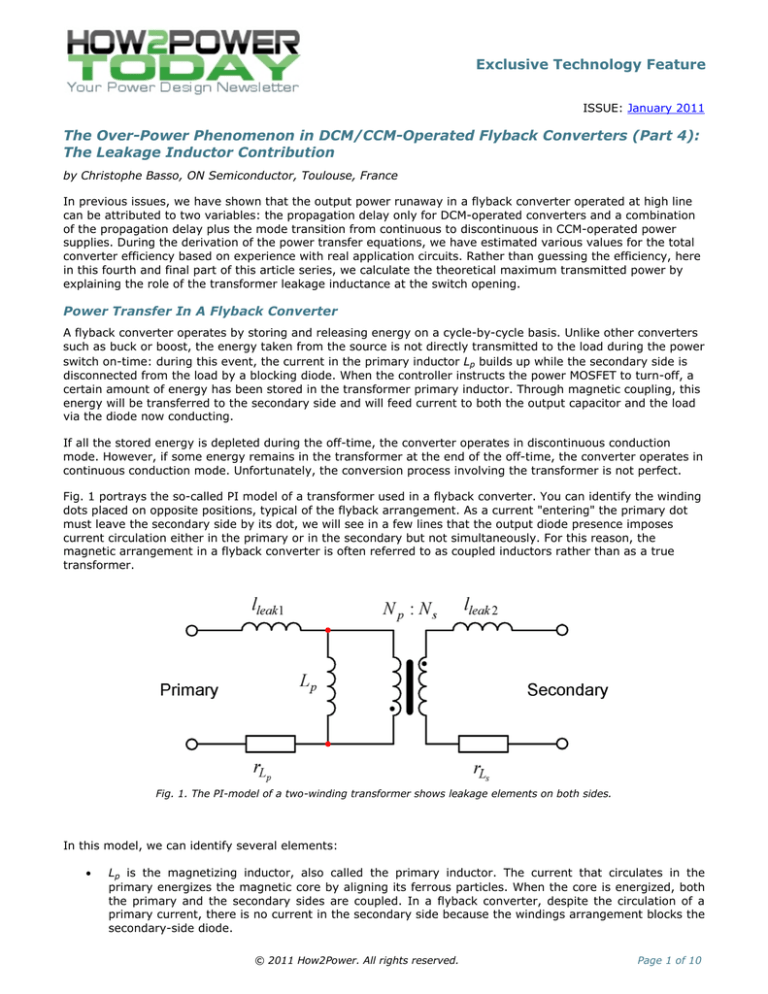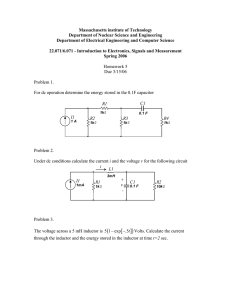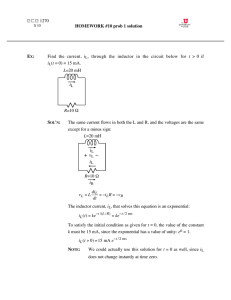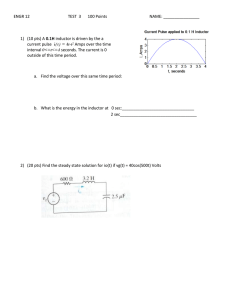
Exclusive Technology Feature
ISSUE: January 2011
The Over-Power Phenomenon in DCM/CCM-Operated Flyback Converters (Part 4):
The Leakage Inductor Contribution
by Christophe Basso, ON Semiconductor, Toulouse, France
In previous issues, we have shown that the output power runaway in a flyback converter operated at high line
can be attributed to two variables: the propagation delay only for DCM-operated converters and a combination
of the propagation delay plus the mode transition from continuous to discontinuous in CCM-operated power
supplies. During the derivation of the power transfer equations, we have estimated various values for the total
converter efficiency based on experience with real application circuits. Rather than guessing the efficiency, here
in this fourth and final part of this article series, we calculate the theoretical maximum transmitted power by
explaining the role of the transformer leakage inductance at the switch opening.
Power Transfer In A Flyback Converter
A flyback converter operates by storing and releasing energy on a cycle-by-cycle basis. Unlike other converters
such as buck or boost, the energy taken from the source is not directly transmitted to the load during the power
switch on-time: during this event, the current in the primary inductor Lp builds up while the secondary side is
disconnected from the load by a blocking diode. When the controller instructs the power MOSFET to turn-off, a
certain amount of energy has been stored in the transformer primary inductor. Through magnetic coupling, this
energy will be transferred to the secondary side and will feed current to both the output capacitor and the load
via the diode now conducting.
If all the stored energy is depleted during the off-time, the converter operates in discontinuous conduction
mode. However, if some energy remains in the transformer at the end of the off-time, the converter operates in
continuous conduction mode. Unfortunately, the conversion process involving the transformer is not perfect.
Fig. 1 portrays the so-called PI model of a transformer used in a flyback converter. You can identify the winding
dots placed on opposite positions, typical of the flyback arrangement. As a current "entering" the primary dot
must leave the secondary side by its dot, we will see in a few lines that the output diode presence imposes
current circulation either in the primary or in the secondary but not simultaneously. For this reason, the
magnetic arrangement in a flyback converter is often referred to as coupled inductors rather than as a true
transformer.
Fig. 1. The PI-model of a two-winding transformer shows leakage elements on both sides.
In this model, we can identify several elements:
•
Lp is the magnetizing inductor, also called the primary inductor. The current that circulates in the
primary energizes the magnetic core by aligning its ferrous particles. When the core is energized, both
the primary and the secondary sides are coupled. In a flyback converter, despite the circulation of a
primary current, there is no current in the secondary side because the windings arrangement blocks the
secondary-side diode.
© 2011 How2Power. All rights reserved.
Page 1 of 10
Exclusive Technology Feature
•
•
•
Lleak1 and Lleak2 are symbols that signify the imperfect coupling between the primary and the secondary
sides. In other words, some induction lines on the primary side as well as on the secondary side, do not
close in the opposite winding but in the air—this is a leak. This leak is expressed by the presence of the
series inductors Lleak1 and Lleak2. As Lleak1 and Lp appear in series, a current crossing Lp is also flowing in
Lleak1.
Np:Ns represents the effective turns ratio between both windings. For convenience, this ratio is often
normalized to the primary and noted N. For instance, if N = 0.05, it implies a turns ratio of 1:0.05,
meaning that the secondary winding has an amount of turns equal to that of the primary divided by 20.
rLp and rLs are resistors representing the dc conduction losses of the copper wires.
This model can be further complicated by adding capacitors or extra terms such as core losses or non-linear
behaviors. On the other hand, we will use a simpler version of this PI-model consisting of a single leakage term
lleak and one primary inductor Lp. We can further simplify the approach by considering a turns ratio of 1, without
isolation at all. As such, Fig. 2 represents a flyback converter during the on-time where both Lp and lleak clearly
appear in series. Vclamp portrays the clamping voltage provided by the RCD network or the transient voltage
suppressor (TVS) present in most commercial flyback designs.
Vclamp
I p (t )
Vin
Lp
I p (t )
lleak
N=1
Fig. 2. The flyback converter during the on-time energizes the transformer primary inductor but
also the leakage inductor.
During the on-time, a current Ip flows in the transformer primary and ramps up with a slope defined by:
Son =
Vin
L p + lleak
(1)
© 2011 How2Power. All rights reserved.
Page 2 of 10
Exclusive Technology Feature
No current circulates in the secondary side as the dot arrangement of the transformer reverse-biases the output
diode. When the primary-side peak current reaches the target imposed by the controller, Ipeak, the power
MOSFET opens. At this time, the primary voltage reverses in an attempt to keep the amperes-turns constant.
The secondary-side diode now conducts, offering a path to the primary current Ip (t) through the coupling of
both windings. Since the diode conducts, the output voltage Vout plus the forward voltage drop of the rectifier,
Vf, are reflected across the primary inductor, forcing the current to decrease with a slope of:
Soff =
Vout + V f
(2)
Lp
However, the current suddenly interrupted in the leakage inductor also keeps flowing in the same direction. To
avoid any discontinuity, besides the capacitance on the drain, a safe path has to be offered to this current. In a
classical design, it will go to the low-impedance voltage source Vclamp, depleting the energy stored in the
leakage inductor. As confirmed by Fig. 3, the leakage inductor undergoes a voltage equal to Vclamp minus the
reflected voltage (Vout + Vf) imposing a downslope equal to:
Slleak =
Vclamp − (Vout + V f
)
(3)
lleak
As both inductors connect in series, a current circulating in the leakage inductor implies the same current
flowing in the primary inductor. Since the primary inductor is feeding the secondary side, the leakage inductor
diverts some of the stored energy, wasting it in heat through the clamping network. As indicated in Fig. 3, the
secondary current is equal to:
I sec
=
( t ) I Lp ( t ) − Illeak ( t )
(4)
Both currents being equal at the switch opening, the secondary-side current ramps from zero and grows until
the leakage inductor current is fully reset. This reset time, ∆t, delays the occurrence of the current on the
secondary side of the transformer at the switch turn-off event.
I Lp ( t ) − I lleak ( t )
Vclamp
I Lp ( t )
I lleak ( t )
Lp
Vout ( t )
I sec ( t )
lleak
Vin
I lleak ( t )
Fig. 3. During the off-time, as a current also flows in the leakage inductor, it diverts some of the
energy stored in the primary inductor until the leakage inductor reset occurs.
© 2011 How2Power. All rights reserved.
Page 3 of 10
Exclusive Technology Feature
When the leakage inductor is reset, the secondary-side current is equal to the current in the primary inductor:
I sec ( t ) = I L p ( t )
(5)
Unfortunately, at this moment, because the leakage inductor dissipates in heat a portion of the primary energy,
the primary current is no longer equal to Ipeak, the value at which the MOSFET opens: it has decreased to a
lower value, designated as point A in Fig. 4. This is the effective secondary-side peak current value. The offtime then lasts until the primary inductor current either reaches zero (DCM) or its valley value in the case of
CCM. The downslope is calculated by equation (2).
I Lp ( t )
I peak
Primary inductor
current
A
I valley
I lleak ( t )
I peak
Leakage inductor
current
I sec ( t )
I sec, peak
Secondary side
current
I sec,valley
∆t
ton
toff − ∆t
Fig. 4. The leakage inductor needs time to be reset. This time actually delays the current transfer
from primary to secondary.
The Average Output Current
Capitalizing on Fig. 4 waveforms, we can now derive a few equations to estimate the maximum dc output
current flowing in the output diode when the controller detects a fault condition. First off, we need to estimate
the leakage inductor reset time, ∆t. We know that the inductor peaks to Ipeak before dropping to zero with a
slope given by equation (3). Therefore, we have:
=
∆t
I peak
lleak I peak
=
Slleak Vclamp − (Vout + V f
)
(6)
If we now consider a transformer turns ratio N different from 1, this equation becomes:
lleak I peak
∆t =
Vclamp − (Vout + V f
)
(7)
N
© 2011 How2Power. All rights reserved.
Page 4 of 10
Exclusive Technology Feature
Point A in Fig. 4 is the point reached by Ipeak in ∆t when falling down at a slope Sleak:
I A = I peak − Soff ∆t
(8)
Using equations (7) and (3), we can update and derive an expression for the peak secondary current when the
leakage inductor is reset:
=
I A I peak −
(V
out
+ Vf
NL p
)
Nlleak I peak
NVclamp − (Vout + V f
)
(9)
If we rearrange this equation and scale the current at point A by N to the secondary side, we obtain:
I peak lleak
1
1−
I=
sec, peak
N
L p NVclamp
−1
Vout + V f
(10)
If the converter is operated in CCM, the secondary valley current does not change since there is no contribution
from the leakage term anymore:
I sec, valley =
I valley
(11)
N
Having these two formulas on hand, we can now calculate the secondary-side ripple current ∆IL:
∆I L ,sec= I sec, peak − I sec, valley
(12)
To help calculate the average output current, Fig. 5 offers a magnified view of the secondary-side current
during the off-time.
I sec ( t )
I sec, peak
A1
∆I L ,sec
A2
I sec,valley
A3
∆t
toff − ∆t
t
toff
Fig. 5. The average current on the secondary side is obtained by dividing the current signal into
surfaces, individually calculated.
To estimate the average value of such a waveform, the simplest way is to slice it into easily calculable surfaces
and sum them together before dividing by the signal period:
© 2011 How2Power. All rights reserved.
Page 5 of 10
Exclusive Technology Feature
I sec,avg =
A1 + A2 + A3
Tsw
(13)
Now using equations (7), (10), (11) and (12), we derive the following expression for the dc current circulating
in the output diode:
I sec, peak ∆t
I sec, avg =
2
+
∆I L ( toff − ∆t )
2
+ I sec, valley ( toff − ∆t )
Tsw
(14)
This expression is the dc current flowing in the output diode and delivered to the load. The ac portion of the Fig.
5 signal goes to the output capacitor. In a fault condition (an overload situation, for instance), the controller
pushes the primary-side peak current to its maximum. We have seen that if the maximum allowed sensedvoltage is Vsense, then the maximum peak current in the transformer at the switch opening is:
=
I p ,max
Vsense ,max
Rsense
+
Vin
t prop
Lp
(15)
where Vsense is fixed at 800 mV in an NCP1250 from ON Semiconductor, Rsense is the external sense resistor, Vin
is the input voltage (low line, Vin,LL and high line Vin,HL) and tprop is the total propagation delay of the controller,
including the driving path to the MOSFET. With all these elements on hand, we can now compute the maximum
power in a numerical example.
Computing the Transmitted Power
Let's assume we have built a 65-W converter featuring the following component values and operating voltages:
Vin,HL is the dc input voltage at high line, 370 V
Vin,LL is the dc input voltage at low line, 120 V
Vout is the dc output voltage, 19 V
Lp is the transformer primary inductance, 600 µH
lleak is the transformer leakage inductance, 2 µH
tprop is the total propagation delay, 350 ns
Rsense is the sense resistor, 0.33 Ω
Vsense is the maximum authorized sense value, 0.8 V
Tsw is the switching period for a 65-kHz frequency, 15.4 µs
N is the turns ratio between the secondary and the primary sides, 0.25
Vclamp is the selected clamping level on the RCD network, 107 V
ηLL is the converter efficiency at low line, 85%
ηHL is the converter efficiency at high line, 89%
© 2011 How2Power. All rights reserved.
Page 6 of 10
Exclusive Technology Feature
First, we can calculate the peak current in a fault condition at low line and high line:
I peak ,max, LL =
Vsense ,max
I peak ,max, HL =
Vsense ,max
Rsense
Rsense
+
Vin , LL
+
Vin , HL
Lp
Lp
t prop =
0.8 120
+
× 350n = 2.49 A
0.33 600u
(16)
t prop =
0.8
370
+
× 350n = 2.64 A
0.33 600u
(17)
Next is the valley-current calculation, changing between the two input-line conditions. It has been derived in
part 2 of this series of articles:
TswVin , LL (V f + Vout )
15.4u × 120 × (19 + 0.5 )
=
=
I valley , LL =
I peak ,max, LL −
2.49 −
1.28 A (18)
600u × (19 + 0.5 + 0.25 × 120 )
L p (V f + Vout + NVin , LL )
TswVin , HL (V f + Vout )
15.4u × 370 × (19 + 0.5 )
I valley , HL =
I peak ,max, HL −
2.64 −
0.99 A (19)
=
=
600u × (19 + 0.5 + 0.25 × 370 )
L p (V f + Vout + NVin , HL )
Equation (14) requires the value of the off-time at both input conditions. It can easily be calculated using
primary values as follows:
toff =
N ( I peak ,max − I valley )
(V
out
+ Vf
)
Lp
(20)
At the two extremes, toff becomes:
We now need to calculate the leakage inductor reset time ∆t under both input-line conditions:
∆t LL
Nlleak I peak ,max, LL
0.25 × 2u × 2.49
=
= 171ns
NVclamp − (Vout + V f ) 0.25 × 107 − (19 + 0.5 )
(23)
∆t HL
Nlleak I peak ,max, HL
0.25 × 2u × 2.64
=
= 182 ns
NVclamp − (Vout + V f ) 0.25 × 107 − (19 + 0.5 )
(24)
© 2011 How2Power. All rights reserved.
Page 7 of 10
Exclusive Technology Feature
From these numbers, we can evaluate the secondary-side peak current when the leakage inductor is reset:
I sec, peak , LL=
I sec, peak , HL=
I peak ,max, LL
N
I peak ,max, HL
N
l
1
2.49
2
1
u
1 − leak
=
× 1 −
×
= 9.9 A
0.25
600u 0.25 × 107 − 1
L p NVclamp
−1
19 + 0.5
+
V
V
out
f
(25)
l
1
2.64
2
1
u
1 − leak
=
× 1 −
×
= 10.4 A
0.25
600u 0.25 × 107 − 1
L p NVclamp
−1
19 + 0.5
Vout + V f
(26)
From the above equations, we can derive the secondary-side ripple current:
∆I L ,sec, LL =I sec, peak , LL −
I valley , LL
∆I L ,sec, HL = I sec, peak , HL −
I valley , HL
N
N
=9.9 −
1.28
=4.78 A
0.25
(27)
0.99
=6.44 A
0.25
=10.4 −
(28)
Now, it is time to apply the average current formula given by equation (14):
I sec, peak , LL ∆t LL
I sec, avg , LL =
I sec, avg , LL
2
∆I L ,sec, LL ( toff , LL − ∆t LL )
2
+ I sec, valley , LL ( toff , LL − ∆t LL )
(29)
Tsw
9.9 × 171n 4.78 × ( 9.3u − 171n ) 1.28
+
+
× ( 9.3u − 171n )
846n + 21.8u + 46.7u
2
2
0.25
=
= = 4.5 A
15.4u
15.4u
I sec, peak , HL ∆t HL
I sec, avg , HL =
I sec, avg , LL
+
2
+
∆I L ,sec, HL ( toff , HL − ∆t HL )
2
(30)
+ I sec, valley , HL ( toff , HL − ∆tHL )
Tsw
10.4 × 182n 6.44 × (12.7u − 182n ) 0.99
+
+
× (12.7u − 182n )
946n + 40.3u + 49.6u
2
2
0.25
=
= = 5.9 A
15.4u
15.4u
© 2011 How2Power. All rights reserved.
(31)
(32)
Page 8 of 10
Exclusive Technology Feature
To check our calculations, we built a 65-W power supply using the new NCP1250. The adopted schematic
appears in Fig. 6.
Fig. 6. A prototype adapter has been built using the NCP1250 where the OPP pin (pin 1) is
grounded.
Pin 1, which is the Over-Power Protection pin, has purposely been grounded. To check the maximum power that
could be delivered before the protection circuit actually trips, we powered the converter at two dc input voltages
(120 V and 370 V) while applying a variable load at its output. At low line, we found a maximum dc current of
4.2 A, which rose to 5.9 A at high line.
If we compare these measured values with the results given by equations (30) and (32), a 7% error occurs at
low line only. The discrepancy in the numbers can be explained by several variables such as a reduction of the
primary inductance as the transformer heats up at low line or by a slight change of the RCD clamping network
voltage. This voltage could influence the leakage inductor reset time and affect the average output current.
Nevertheless, these calculations instruct the designer that a means of limiting the output power has to be
implemented. Through this analytical approach, OPP can be incorporated during the initial flyback design stage
and then verified when the prototype is assembled.
Conclusion
This final part of the article series on over-power protection explains the influence of the leakage inductor in the
power transfer of a flyback converter. It is important to understand the role of the leakage inductor, which
delays the rise of the secondary-side current and reduces the available output current. By diverting a portion of
the primary-side stored energy, it affects the total efficiency of the converter.
References:
1. C. Basso, "The Over-Power Phenomenon In DCM/CCM-Operated Flyback Converters (Part 1)" How2Power
Today, October 2010.
2. C. Basso, "The Over-Power Phenomenon in DCM/CCM-Operated Flyback Converters (Part 2): FixedFrequency CCM Operation" How2Power Today, November 2010.
3. C. Basso, "The Over-Power Phenomenon in DCM/CCM-Operated Flyback Converters (Part 3): Quasi—Square
Wave Resonant Mode” How2Power Today, December 2010.
© 2011 How2Power. All rights reserved.
Page 9 of 10
Exclusive Technology Feature
About The Author
Christophe Basso is an application engineering director at ON Semiconductor in Toulouse,
France. He has originated numerous integrated circuits among which the NCP120X series has
set new standards for low standby power converters. SPICE simulation is also one of his
favorite subjects and he authored a second book, “Switch-Mode Power Supplies: SPICE
Simulations and Practical Designs”, published by McGraw-Hill in 2008. His work was positively
reviewed in several magazines and in a recent PELS newsletter. Christophe holds a BSEEequivalent from the Montpellier University, France and a MSEE from the Institut National
Polytechnique de Toulouse, France. He holds 17 patents on power conversion and often
publishes papers in conferences and trade magazines.
For further reading on power protection, see the How2Power Design Guide, search the Design Area category
and select Power Protection as the subcategory.
© 2011 How2Power. All rights reserved.
Page 10 of 10





